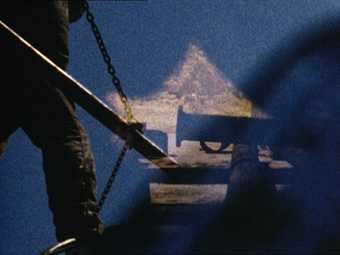Mid June, 1968.
Dear Bruce,
You brought me, via your tape, enough joy and thought provocation in Kalamazoo to keep me going all-of-a-piece thru the second very terribly difficult day there. (…) As for your films—ah well… what sheer loveliness as, in the later work, extended with exactitude AND mystery into the film form it engenders for itself—exactly mysterious would be the simplest expletive I could applaud it with… and that’s just a tongue-clap in lieu of saying, more simply, “BRAVO!”
Stan Brakhage
For more than five decades, Bruce Baillie corresponded with Stan Brakhage, sharing fascinating letters, films and even audiotapes recorded from a van on the road. This programme points to some of the connections and affinities between these two friends’ universes.
Programme
Bruce Baillie, Roslyn Romance (Is It Really True?), USA 1977, 16mm, colour, sound, 17 min
When I was filming while living in the small Washington mountain town, Roslyn, I noticed it was to be a romance, in the sense of narrative, as well as a question: “Is it really true?’ (i.e., what my neighbors held to be reality?) I began my inquiry in this locus, this film with a ‘postcard form’ – I would share, mail, exhibit the reels of film during and after as if they were ‘correspondence with a dear friend’
Bruce Baillie
Stan Brakhage, The Machine of Eden, USA 1970, 16mm, colour, silent, 14 min
Brakhage’s dreamy vision of pastoral America uses the mechanics and artifacts of a 16mm film camera to reimagine landscapes.
Bruce Baillie, Castro Street, USA 1966, 16mm, colour and black and white, sound, 10 min
Inspired by a lesson from Erik Satie: a film in the form of a street – Castro Street – running by the Standard Oil Refinery in Richmond, California … switch engines on one side, and colorful Standard Oil refinery tanks, smoke stacks, and buildings on the other – the street and film, ending at a lumber company, colored red.
Bruce Baillie
Stan Brakhage, The Wonder Ring, USA 1955, 16mm, colour, silent, 6 min
Commissioned by Joseph Cornell, The Wonder Ring is Brakhage’s record of New York City’s now-terminated Third Avenue elevated railway.
Bruce Baillie, Tung, USA 1966, 16mm, colour and black and white, silent, 5 min
‘Portrait of a friend named Tung, deriving directly from a momentary image on waking … “Seeing / her bright shadow / she was someone / I / you / we / had known.”’
Bruce Baillie
Stan Brakhage, Stellar, USA 1993, 16mm, colour, silent, 3 min
One of the collaborations between Brakhage and optical printer Sam Bush – a short that hurdles through its kaleidoscopic images.
Bruce Baillie, Still Life, USA 1966, 16mm, colour, sound, 2 min
One continuous, intimate shot from within the commune … The film manages, I think, to suggest how light itself is movement, how color is movement, and how the combined play of light and color reveal that this tableau represents not only a single reality but 24 realities per second. Being is seen as transitory; everything is in the infinite process of becoming.
Bruce Baillie
Stan Brakhage, I … Dreaming, USA 1988, 16mm, colour, sound, 8 min
With music by Joel Haertling and Stephen Foster, I … Dreaming envisions melancholia and love through home video footage and words etched across the film’s frames.
Bruce Baillie, All My Life, USA 1966, 16mm, colour, sound, 3 min
A modern favorite! … A mere written description of the work might appear banal: a picket fence paralleling an ancient wooden sewage pipe among cascading, wild red roses – and finally a few telephone wires against the sky. Yet the result is to take an aspect of reality, sift it through the creative Mind, and produce a singular, joyous event!
Bruce Baillie
Introduced by Garbiñe Ortega, series curator
Tate Film is supported by LUMA Foundation

